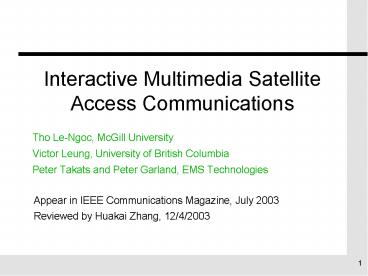Interactive Multimedia Satellite Access Communications - PowerPoint PPT Presentation
1 / 25
Title:
Interactive Multimedia Satellite Access Communications
Description:
... for DiffServ provisioning over BSA systems ... 1. Lack of economical satellite-based return ... TCP over BSA Systems. Why TCP throughput is degraded in ... – PowerPoint PPT presentation
Number of Views:57
Avg rating:3.0/5.0
Title: Interactive Multimedia Satellite Access Communications
1
Interactive Multimedia Satellite Access
Communications
- Tho Le-Ngoc, McGill University
- Victor Leung, University of British Columbia
- Peter Takats and Peter Garland, EMS Technologies
Appear in IEEE Communications Magazine, July
2003 Reviewed by Huakai Zhang, 12/4/2003
2
Outline
- Introduction Broadband Satellite Access(BSA)
- Objective
- IP-Based BSA Systems
- TCP over BSA Systems
- Conclusion
3
Introduction
- Collaborative research in telecommunications
- A Canadian experience
- Dynamic satellite bandwidth allocation
- An architecture for DiffServ provisioning over
BSA systems - A dynamic TCP Vegas protocol as a proxy service
for split-TCP connections over BSA systems
4
Introduction
- Satellite Communication
- An alternative to traditional(terrestrial)
communication - Most satellites operate in the microwave region
- Microwave satellites operate on assigned
frequency bands designated by a letter. Common
communications satellite bands are the C (3.4 to
6.425 GHz) and Ku (10.95 to 14.5 GHz) bands
5
Introduction (cont)
- BSA system configuration
6
Introduction (cont)
- Example (Digital Video Broadcast DVB-RCS)
7
Introduction (cont)
- Broadband Satellite Access(BSA)
- Pros
- 1. Provide connectivity in remote areas,
continental coverage - 2. Avoid unpredictable congestion and delay (only
one hop) - 3. Ideal for real-time multicast and broadcast
services - Cons
- 1. Lack of economical satellite-based
return/interaction - 2. High cost compared to terrestrial technologies
8
Objective
- Dynamic Capacity Allocation
- All User Terminals(UTs) share
- the same return link using a
- Multi-Frequency Time-Division
- Multiple Access (MF-TDMA)
- scheme, which needs to be dynamic
- to ensure efficient return link
- utilization.
9
Objective (media access method 1)
- Random Access ALOHA
- No channel setup/tear-down, but limited channel
- utilization
- Ideal for low data rates/fast response app.,
such as - bank transactions
10
Objective (media access method 2)
- Demand Assigned Multiple Access (DAMA)
- High QoS, but need setup phase to reserve
capacity - Ideal for VoIP and Video Conf. use pre-defined
- constant bit rate, i.e PAR 1
11
Objective (media access method 3)
- Combined Free/DAMA (CFDAMA)
- Freely allocate the remaining capacity to the
UTs to make - the response time small, while keeping good QoS
and high - channel utilization
- Ideal for bursty multimedia services with
diverse QoS - requirements
12
Objective (method 2 vs. method 3)
13
IP-Based BSA Systems
- Goal
- End users are assumed to be IP-based.
- It is desirable for BSA systems to interoperate
seamlessly with the terrestrial IP networks and
to be compatible with IP-based technologies and
protocols.
14
IP-Based BSA Systems (cont)
User Traffic Protocol Stack
15
IP-Based BSA Systems (cont)
T1, T2 handles DiffServ Packet
16
IP-Based BSA Systems (cont)
Simplified drawing of DiffServ Implementation
17
IP-Based BSA Systems (cont)
- Representation of bandwidth assignment with
coordinates of (time, frequency)
18
IP-Based BSA Systems (cont)
- DVB-RCS bandwidth allocation mechanisms
- Continuous Rate Assignments (CRA), VoIP
- Rate Based Dynamic Capacity (RBDC), Web
traffic - Volume Based Dynamic Capacity (VBDC), Email
- Absolute Volume Based Dynamic Capacity (AVBDC)
- Free Capacity Assignment (FCA)
- Mapping for the DiffServ PHB and DVB-RCS
- Expedited Forwarding(EF) ltgt CRA / RBDC
- Assured Forwarding(AF) ltgt RDBC
- Default(DE) ltgt FCA / VBDC
19
TCP over BSA Systems
- Why TCP throughput is degraded in satellite
links? - High delay-bandwidth networks with short
- connection and TCP flow control (e.g. WWW
traffic) - (high packet loss rate, long RTTs)
20
TCP over BSA Systems (cont)
- Solutions
- Link Layer Retransmission and error correction
- End-to-end Extension/options of TCP, e.g. slow
start modification, but very limited - Performance Enhancement Proxy (PEP)
- The most effective one, containing virtual
TCP senders/receivers between terrestrial IP
networks and satellite links
Solutions have to cope with end-user transparency
and/or protocol stack redefinition
21
TCP over BSA Systems (cont)
- Proposed TCP Proxy Service
- Dynamic congestion control mechanism (DVgas),
uncoupling of flow control and error recovery
mechanisms. - Active Queue management by RED
- Immediate Feedback Mechanism results in few
dropped packets
22
TCP over BSA Systems (cont)
- Performance
23
TCP over BSA Systems (cont)
- Effects of Traffic Load and BER on throughput
100 with 10-7 BER, 80 with 10-7 and 20 with
10-6 BER, 20 with 10-6 BER
24
Conclusion
- This paper gives an overview of key innovations
on BSA system architecture. - CFDAMA offer short delay, high channel
utilization. - It is suitable for DiffServ provisioning over BSA
systems - A proxy service to improve TCP performance is
presented.
25
Question?

